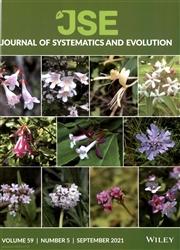杨树和胡杨的分布、起源和分类研究
IF 2.9
1区 生物学
Q1 Agricultural and Biological Sciences
引用次数: 0
摘要
杨树的分类是一项具有挑战性的任务,尤其是在地形复杂的地区,如青藏高原,因为杂交、不完全的品系分类、表型可塑性和趋同性的影响。在《中国植物志》中,杨属植物假杨和杨属植物圆叶杨被划分为杨科(sect.Leucoides科和Tacamahaca科。但它们的分类仍不清楚。通过对高原上所有杨属植物的系统调查,我们发现了这两个科的 31 个类群。通过基于形态和生境的鉴定,我们确认了《四川植物志》中记载的 "P. pseudoglanca "并非真正的P. pseudoglanca,而《中国植物志》中记载的P. pseudoglanca和P. wuana可能指的是同一物种。通过对 31 个类群中的 150 个个体进行全基因组重测序,我们获得了 228 万个单核苷酸多态性(SNPs)。进一步的遗传和系统进化分析表明,P. wuana 的遗传结构与 P. pseudoglanca 极其一致,它们都起源于杨科(Populus ciliata in sect.Leucoides科的杨树 ciliata 和 Tacamahaca 科的杨树 curviserrata 之间的自然杂交。Tacamahaca。我们的研究结果表明,在分类学上应将 P. wuana 与 P. pseudoglanca 合并。这项研究不仅澄清了与 P. pseudoglanca 和 P. wuana 相关的分类混淆,还提供了一个基于形态学、分布、生境和基因组整合的新框架,以解决复杂的分类问题。本文章由计算机程序翻译,如有差异,请以英文原文为准。
A study on the distribution, origin, and taxonomy of Populus pseudoglauca and Populus wuana
Taxonomy of Populus is a challenging task, especially in regions with complex topography, such as the Qinghai–Tibet Plateau because of the effect of hybridization, incomplete lineage sorting, phenotypic plasticity, and convergence. In the Flora of China , Populus pseudoglanca and Populus wuana are classified into sect. Leucoides and sect. Tacamahaca , respectively, but their taxonomy remains unclear. By conducting a systematic investigation for all taxa of Populus on the plateau, we found 31 taxa from the two sections. Through identification based on morphology and habitats, we confirmed that the “P. pseudoglanca ” recorded in the Flora of Sichuan is not true P. pseudoglanca , while P. pseudoglanca and P. wuana recorded in the Flora of China may refer to the same species. By performing whole‐genome re‐sequencing of 150 individuals from the 31 taxa, we derived 2.28 million single nucleotide polymorphisms (SNPs). Further genetic and phylogenetic analyses demonstrated that the genetic structure of P. wuana is extremely consistent with P. pseudoglanca , and they all originate through the natural hybridization between Populus ciliata in sect. Leucoides and Populus curviserrata in sect. Tacamahaca . Our results suggested that P. wuana should be merged with P. pseudoglanca taxonomically. This study not only clarifies the taxonomic confusions related to P. pseudoglanca and P. wuana but also provides a new framework based on the integration of morphology, distribution, habitat, and genome to solve complex taxonomic problems.
求助全文
通过发布文献求助,成功后即可免费获取论文全文。
去求助
来源期刊

Journal of Systematics and Evolution
Agricultural and Biological Sciences-Ecology, Evolution, Behavior and Systematics
CiteScore
7.40
自引率
8.10%
发文量
1368
审稿时长
6-12 weeks
期刊介绍:
Journal of Systematics and Evolution (JSE, since 2008; formerly Acta Phytotaxonomica Sinica) is a plant-based international journal newly dedicated to the description and understanding of the biological diversity. It covers: description of new taxa, monographic revision, phylogenetics, molecular evolution and genome evolution, evolutionary developmental biology, evolutionary ecology, population biology, conservation biology, biogeography, paleobiology, evolutionary theories, and related subjects.
 求助内容:
求助内容: 应助结果提醒方式:
应助结果提醒方式:


